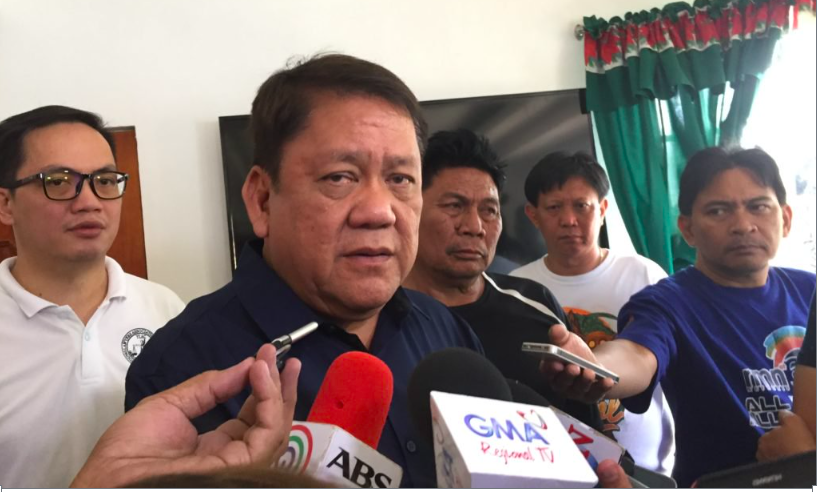
Former Cebu City mayor Tomas Osmena’ raises concerns about the changes to the Bus Rapid Transit (BRT) system in Cebu in a letter dated July 29, 2019 addressed to the National Economic Development Authority-Investment Coordinated Committee (NEDA-ICC). | CDN FILE PHOTO
CEBU CITY, Philippines— “Investigate the changes to the Bus Rapid Transit (BRT) system in Cebu City.”
This was former Cebu City mayor Tomas Osmena’s request to the National Economic Development Authority-Investment Coordinated Committee (NEDA-ICC) in a letter dated July 29, 2019.
Osmena said there is a need for NEDA-ICC to investigate the changes that the Department of Transportation (DOTr) plans to implement on the BRT project. These changes include the shortened route to 13 kilometers form the original 23 kilometers.
The changes to the original BRT plan was also discussed during the executive session of the Cebu City Council held on Tuesday, August 20, with Vice Mayor Michael “Mike” Rama himself stepping down as presider to participate in the discussion.
“There are too much changes that I can no longer see the original (plan), why so?,” said Rama.
Changes
Osmeña was the mayor when the BRT project for Cebu City was conceptualized in 2008. Rama was the vice mayor.
Rama continued pushing for the project when he sat as mayor from 2010 to 2016.
Osmeña, in his letter to the Neda-ICC in July 2019 but was only furnished to the media on August 21, wrote a detailed report of the BRT changes to realign the project with DOTr’s Integrated Intermodal Transport System (IITS) which includes a monorail and cable cars.
In particular, Osmeña said he was concerned with the cutting down of the route from its original 23 kilometers to 13 kilometers.
Originally, the BRT should star at the the Natalio Bacalso Street in Barangay Bulacao to the Cebu IT Park in Barangay Apas.
The new route, which was proposed by the Office of the Presidential Assistant to the Visayas, will start from the South Road Properties (SRP) and will end at the Cebu IT Park.
Osmeña was concerned that cutting the BRT route and the reduction of the service plans from seven to one would eliminate the purpose of the project: to bring the people from their homes to the workplaces and vice-versa with as many trips as possible.
He said the feeder system, which is comprised of modernized jeepneys that will bring people to the BRT stations, will provide inconvenience to the public because it means that passengers will have to take two trips to go home.
Another concern raised by Osmeña centred on the feasibility of the new plan.
Unlike the original BRT plan, which was evaluated by the ICC-Technical Board and boasts of a ‘robust’ Economic Internal Rate of Return (EIRR), Osmeña said the new plan did not undergo a full-blown feasibility study.
“Prudence dictates that changes such as these must be assessed thoroughly for the good of the country. It is indeed the NEDA-ICC’s basic policy before, which I am sure is retained now, that any change in scope or cost greater than 15 percent requires re-evaluation of the ICC,” said Osmeña.
Osmeña clarified that he does not oppose the IITS and the plans for a monorail and cable cars in alignment with the BRT.
Osmeña said he wanted to ensure that the needs of the Cebu City commuters’ needs remain a priority through a feasible and effective BRT system.
City council
The Cebu City Council raised the same concerns during the executive session on August 20, which was also attended by NEDA executives in Central Visayas and three planning and design specialists of the Manila Bus Rapid Transit, the same team who are handling the BRT project.
Vice Mayor Rama stepped down as presider of the Cebu City Council to participate in the discussion.
He also raised his own concerns over the changes of the BRT to the specialists and NEDA representatives. Cebu City Councilor Eduardo Rama, Jr. presided over the executive session.
The three specialists, led by Melena Suarez, clarified that is “cutting of the original route” or what Osmeña stated in the letter as a shortened route from 23 kilometers to 13 kilometers.
They said the changes was all about managing the project according to phases.
This means that the SRP to IT Park route will be prioritized in the first phase while the Bulacao N. Bacalso to SRP route will follow in the next phase along with an extended route to Talisay City.
Opposition councilors Nestor Archival and Eugenio Gabuya, Jr. asked about the length of time it will take for the BRT to be accomplished.
The specialists said they could not give a specific date as the road widening will require land acquisition. They said the acquisition of the right of way may take to time because of the many establishments that will be affected by the road widening.
The Council agreed to help push for the acquisition of the right of way for the road widening to hasten the completion of the BRT.
Vice Mayor Rama described the BRT as a project that the “people of Cebu City has long been waiting for” and asked the NEDA and BRT specialists to speed up its completion. / celr

